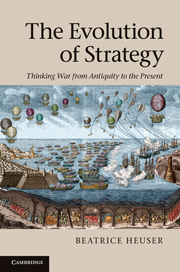Book contents
- Frontmatter
- Contents
- Acknowledgements
- A note on referencing
- Part I Introduction
- PART II Long-term constants
- PART III The Napoleonic paradigm and Total War
- PART IV Naval and maritime Strategy
- PART V Air Power and nuclear Strategy
- 12 War in the third dimension
- 13 Four schools of air power
- 14 Nuclear Strategy
- PART VI Asymmetric or ‘small’ wars
- PART VII The quest for new paradigms after the World Wars
- Bibliography
- Index
12 - War in the third dimension
from PART V - Air Power and nuclear Strategy
Published online by Cambridge University Press: 05 June 2012
- Frontmatter
- Contents
- Acknowledgements
- A note on referencing
- Part I Introduction
- PART II Long-term constants
- PART III The Napoleonic paradigm and Total War
- PART IV Naval and maritime Strategy
- PART V Air Power and nuclear Strategy
- 12 War in the third dimension
- 13 Four schools of air power
- 14 Nuclear Strategy
- PART VI Asymmetric or ‘small’ wars
- PART VII The quest for new paradigms after the World Wars
- Bibliography
- Index
Summary
Whoever is master of the air will be master of the world.
(General Jean-Henri Jauneaud, q.i. Artzet 1999: 47)[F]light … is still so new, so beautiful … so swift, that its value in peace and war … is bound to be somewhat magnified … [T]he result is that we tend to ascribe to it boundless potentialities and to reject other implements of war as outmoded. We are under the sway of a dogma of innovation, just as blind and as dangerous as that [claiming] there is nothing essentially new in war.
(Bernard Brodie 1942: 193)Child and grandchild of naval Strategy
We have seen that writing on naval warfare differed in many points from that on land warfare. Air Strategy emerged in most ways as the child of naval or maritime Strategy, and much less of thinking on land warfare. The main tenet inherited from the land Strategy thinkers was the Clausewitzian war aim of ‘imposing one’s will upon the enemy’.
The inheritance from naval thinking was both much larger and more detailed. The three crucial bequests from naval writing to air power theory were:
the debate about whether the navy’s (or as it might be the air force’s) actions should be subordinated to the needs of land warfare, which was essentially the argument of Corbett;
the claim that the navy (or then, the air force) could win a war more or less on its own, mainly in a central and decisive naval battle (or strategic air campaign);
the perceived possibility of using the navy (or later, the air force) to circumvent the enemy’s strongest or hardest part, his military forces, and carry the war directly to the enemy’s vital but softest part, his civilian populations in his big cities. While the overall aim of advocates of this route – through blockade or city bombing – was to defeat the enemy state, not to annihilate his population in a genocidal fashion, a Social Darwinist element resonated in this thinking.
Some concepts – such as command of the sea/command of the air, sea power/air power – could be transposed one to one. Other translation of ideas from naval and maritime Strategy to air Strategy included cross-overs and mergers of the ideas of several ‘schools’ on maritime Strategy. At times, the genealogy of ideas can be explicitly traced, as was particularly true for the writers on general Strategy in the nineteenth and early twentieth centuries and their influence on naval/maritime Strategy thinkers. But with the growth of formal educational curricula and cheaply available specialist periodicals in the nineteenth and early twentieth centuries, ideas spread in ways that elude specific tracing. Some were ‘in the air’: when finding in somebody’s writing on air Strategy traces of a previous author’s or school’s ideas, we often cannot prove that these were consciously assimilated. In some cases a certain idea may well have been reinvented, rediscovered. In others, two individuals, dealing with similar questions, having read similar things, may independently have hit upon very similar answers.
- Type
- Chapter
- Information
- The Evolution of StrategyThinking War from Antiquity to the Present, pp. 297 - 312Publisher: Cambridge University PressPrint publication year: 2010



